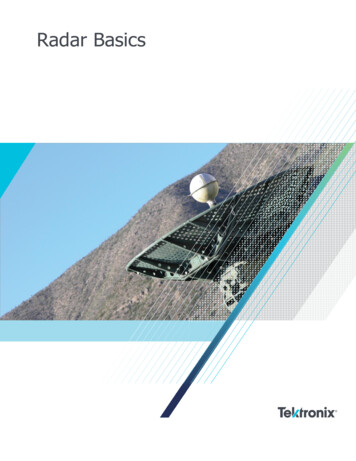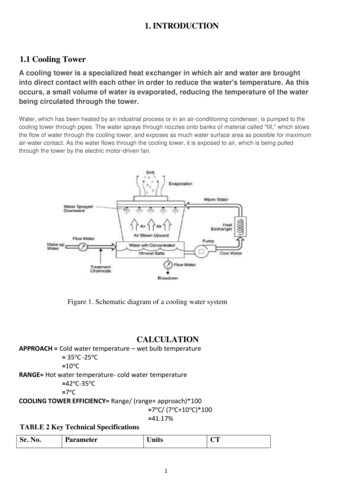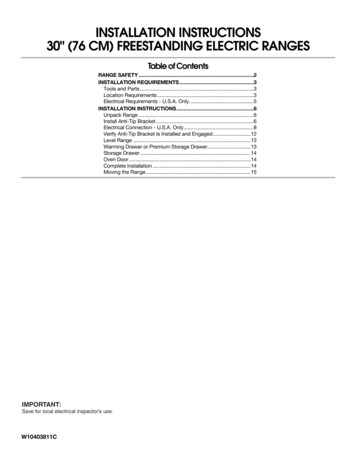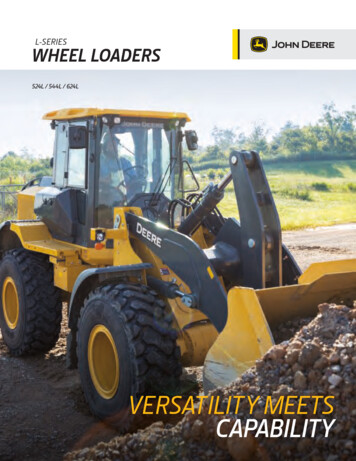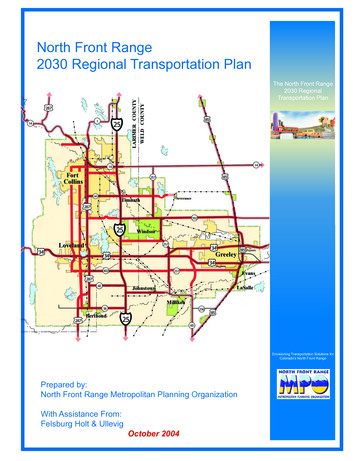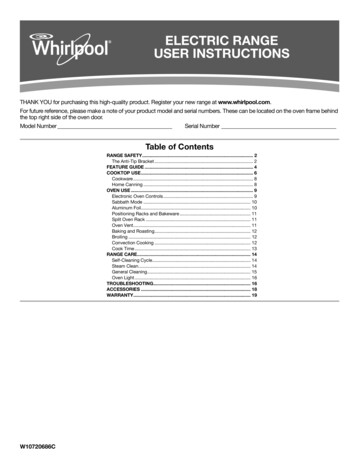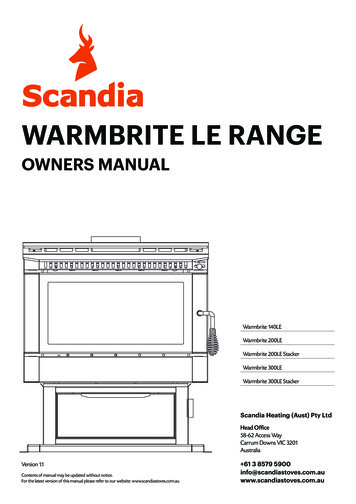
Transcription
WARMBRITE LE RANGEOWNERS MANUALWarmbrite 140LEWarmbrite 200LEWarmbrite 200LE StackerWarmbrite 300LEWarmbrite 300LE StackerScandia Heating (Aust) Pty LtdHead Office58-62 Access WayCarrum Downs VIC 3201AustraliaVersion 1.1Contents of manual may be updated without notice.For the latest version of this manual please refer to our website: www.scandiastoves.com.au 61 3 8579 .au
SCANDIA WARMBRITE RANGEModel NameModel NumberWarmbrite 140LESCWB140LEWarmbrite 200LESCWB200LEWarmbrite 200LE StackerSCWB200LE-STWarmbrite 300LESCWB300LEWarmbrite 300LE StackerSCWB300LE-STCONTENTSWood heater safety2Before installing your wood heater3Installation4Firebox Assembly10Operating your wood heater11Wood heater maintenance13Trouble shooting15Warranty16Exploded diagram / Spare parts list18INTRODUCTIONCongratulations on purchasing a genuine Scandia Wood heater. When cared for properly, these high quality,finely crafted wood heaters will offer many years of reliable performance. This instruction manual has beendeveloped to ensure optimum performance from your Scandia wood heater. It’s very important that youthoroughly read and understand all instructions before using your new wood heater.COUNCIL REQUIREMENTSCheck Local Council Requirements Eg. permitsWhen installing, operating and maintaining your wood heater, follow the guidelines presented in these instructions,and make them available to anyone using or servicing the wood heater.Your city, town, state or territory may require a building permit to install a solid fuel burning appliance.Always consult your local building inspector or local council to determine what regulations apply in your area.Please note:Your wood heater must be installed by a qualified person whosework conforms with local council regulations, New Zealandstandards & manufacturers recommendations. Failure to do so willvoid your warranty and could possibly void any home insurance.1.
WOOD HEATER SAFETYWhen properly maintained and operated your wood heater should give you many years of service,however there are important safety aspects of these products that you need to be aware of when operating a wood heater.1.This appliance is not intended for use by persons (including children) with reduced physical, sensory or mentalcapabilities, or lack of experience and knowledge, unless they have been given supervision or instruction concerninguse of the appliance by a person responsible for their safety.2.Children should be supervised to ensure that they do not play with the appliance.3.If the electrical supply cord is damaged, it must be replaced by the manufacturer, it’s service agent or similarly qualifiedpersons in order to avoid hazard.4.Never place combustible items such as but not limited to furniture, fabric or wood within the specified clearancesto combustibles.5.The burning of wood gives off gases which can be extremely dangerous. Wood heaters are designed so that undernormal operating circumstances these gases pass up the flue chimney system and cannot escape into your home,however it is important that your flue system is properly installed and that you check all joints regularly to ensure thatthere are no cracks or gaps, check the door sealing rope and replace when damaged/worn. We recommend a smokealarm be fitted in rooms where wood heaters are installed. Do not use your wood heater in a room where negativepressure conditions exist. Negative pressure environments can cause products of combustion to be drawn from thefireplace into the room. Caution should be taken when using any form of extraction in a room where a wood heater isinstalled.6.This appliance is designed to specifically burn dry softwood. Do not burn rubbish, driftwood, flammable liquidsor any substance containing salts or corrosives.7.Creosote and soot may accumulate in your flue pipe and chimney. This may ignite, causing a chimney fire. If you suspecta chimney fire close down the air controls on the wood heater, if the fire persists evacuate people from the buildingand call the Fire Brigade. To prevent the accumulation of soot or creosote, check flue and chimney regularly and cleanas necessary. Good burning, hot wood heaters will generally cause a lot less build-up than slow burning wood heaters,likewise dry wood will cause less build-up than wet wood. We recommend a fire extinguisher be available where woodheaters are in operation. In the event of a chimney fire do not re-light the wood heater until the heater and the fluechimney system have been thoroughly checked and repaired/replaced as necessary.8.Wood heaters get extremely hot and should not be touched when lit. When young children are in the area, werecommend the use of a suitable fire guard around the wood heater. Always wear protective gloves when reloadingwood heater.9.Never over-fire your wood heater. If external parts of your wood heater are glowing red then the wood heater isover-firing and your draught settings should be reduced. Never interfere with the draught mechanisms or adjust yourair settings outside those limits set when the wood heater is manufactured. Never use a secondary fan to supply orextract air to the wood heater.10.All users of the wood heater should be aware of the contents of this manual. Please leave this manual where it isaccessible to wood heater users and do not allow anyone to use the wood heater that is unfamiliar with its correctoperation.11.Never use the wood heater if any parts are missing or damaged, only use genuine parts as replacements.Never modify your wood heater.2.
BEFORE INSTALLING YOUR WOOD HEATERYou need to consider the following to ensure the safe operation of your wood heater:- Provision of adequate air to support efficient combustion of the fuel.- A well sealed flue/chimney system, hereinafter referred to as the “flue system”.- The protection of combustible materials in proximity of the wood heater.- A suitable base on which to place your wood heater.ADEQUATE PROVISION AIRIt is essential for the safe and efficient use of your wood heater that you provide an adequate air supply to your wood heater.This may mean the provision of an outside air supply to the room, especially if there are extraction units such as cooker hoods orclothes dryers in the vicinity. Failure to do so will mean that fuel is burned inefficiently causing smoke, blackening the glass and mayalso cause smoke to come back into the room. As a simple check for this open a door or window in the room and check if the woodheater burns more efficiently.WELL SEALED FLUE SYSTEMUnder no circumstances should you use aluminum or galvanized steel pipes for your wood heater flue. Always fit pipes with thenarrow crimped side down, this allows any creosote to run down the inside of the pipe and not to come out and cause an unsightlymess and possible fire hazard.Pipe bends should be kept to a minimum and we do not recommend using more than 2 bends on any installation. Flues must notpass through ceilings, floors, attics, roofs, or combustible walls without adequate and approved insulation being provided to protectcombustible materials.The chimney and flue provide a means of taking combusted fuel from the wood heater, as well as a draught to enable the woodheater to work. It is essential that the flue system is kept in good condition and there are no breaks or cracks allowing contact withany other combustible materials of the house. It is also essential that the flue system is kept clean and seals are maintained to ensurethe draught is not lost.The open end of the flue system must be above the height of the apex of the building and any other obstructions, such as trees,which are within 3 meters (10ft) of the flue system. Failure to do this will affect the efficiency of the wood heater and may causedown draughts which will mean dangerous products of combustion are emitted into the room.Under no circumstances should the flue pipe be less than 6” (152mm) internal diameter.CLEARANCES TO COMBUSTIBLESIt is extremely important that you respect required installation distances and that you respect local installation regulations.This is for your safety! The manufacturer is not responsible for the product, if it is not installed following these recommendations.These clearances may only be reduced by means approved by the regulatory authority.A combustible surface is anything that can burn (i.e. plaster, wall paper, wood, fabrics etc.) These surfaces are not limited to thosethat are visible and also include materials that are behind non-combustible materials. If you are not sure of the combustible natureof a material, consult your local fire officials.HEARTH REQUIREMENTSThe floor protector must consist of 9mm thick cement fibre sheet which has a thermal resistance of 0.1m2 K/W, per 9mmthickness or equivalent. Scandia have a complete range of suitable ready to install hearth pads for straight wall and cornerinstallations.3.
INSTALLATIONCLEARANCES TO COMBUSTIBLESE ED DA AF FD DG GB B C CG GSCWB140LESCWB200LE / -STSCWB300LE / -STASide of heater to side wall650* / 550 300 * 425* / 400 BCentre of heater flue to rear wall360* / 310 335* 385* CRear of heater to rear wall225* / 175 175* 225* DFront of heater to hearth front300400* 510* EMinimum hearth width750900* 1000* FMinimum hearth depth1038* / 988 960* 1180* GRear corner of heater to wall550* / 500 100* 175* HMinimum Corner Hearth Depth1396* / 1446 1235* 1518* All measurements are in ‘mm’*When using Scandia default decorative mesh flue kit. (Decorative flue is fitted with an additional heat shield) When using Scandia default Sleek Black / Graphite flue kit. (Sleek black / Graphite flue is fitted with an additional heat shield)Manufacturers recommendation: Keep all combustible materials at least 1.22 metres (4 feet) away from the appliance.This include rugs, fabrics, furnishings, papers, firewood, etc. NEVER dry clothing on or within 1.22 metres of the appliance.4.H H
INSTALLATION .continuedFOR CONNECTING INTO A STANDARD INSTALLATIONUSING SCANDIA DEFAULT FLUE KITSThe following drawing is meant as a guide only. Your wood heater must be installed by a qualified person whose work conformswith local council regulations, Australian/New Zealand standards (AS/NZS 2918:2001) & manufacturers recommendations.Scandia wood heaters are independently tested to New Zealand Standards using a Scandia flue kit, we always recommend usinga Scandia flue kit when installing a Scandia wood fire.ANTI DOWN DRAFT COWLCOVER CONESECURE COVER CONE TO CASING W/ SCREWROOF FLASHING (NOT SUPPLIED IN KIT)RAFTERROOFMIDDLE 8” GALVANISED CASINGMin 25mm from outercasing to any combustiblematerialOUTER 10” GALVANISED CASINGJOISTANGLE BRACKETCEILINGMin 150mm of drop box mustextend from any combustiblesurface including ceilingCERAMIC SPACERSMin 25mmINNER 6” STAINLESS STEEL FLUE(CRIMPED END DOWN)CEILING COLLAR FIXED WITH SCREW,WITH CERAMIC SPACERS BETWEENCEILING COLLAR AND THE CEILINGDECORATIVE CASING POSITION, SEAM TO REAR180 FIXED HEAT SHIELDLOCATION TAGHEATER FLUE COLLARHEATER1.Locate wood fire in it’s proposed position according to manufacturers recommendations.2.Use a plumb bob to mark the ceiling in line with the centre of the flue collar.3.Check that the outer casing will clear all combustible materials by 25mm. Determine positions of noggins to avoidcutting, otherwise headers must be installed for strength.4.Cut a 305mm diameter hole in the ceiling. Directly above cut a hole in the roof to accommodate outer casing.5.Fix the angle brackets to the joists so that the drop box (first length of located casing) is located in the centre of the hole.5.
INSTALLATION .continued6.Position the drop box between the angle brackets, keeping a 25mm clearance to combustibles. The located endof the drop box must protrude no less than 150mm down from the ceiling or any combustible material. Fix the dropbox to the angle brackets.7.Add the remaining casings to the required height. Australian/New Zealand Standards state that “the flue pipe shallextend not less than 4.6m above the top of the floor protector”. If the flue pipe is within 3 metres of the ridge, the fluepipe must protrude at least 600mm above the ridge of the roof. If the distance from the ridge is more than 3 metres,the flue pipe must protrude at least 1000mm above roof penetration. Additional lengths of casing and flue may berequired to achieve this. The flue pipe must be more than 3 metres from any nearby structure. Other clearances maybe applicable, it is up to the installer to ensure compliance with all regulations. See Figure 1 and 2 on P7.8.Install roof flashing (Additional accessory, not supplied in flue kit)9.Secure the Ceiling Collar in place using ceramic spacers and screws provided.10.Insert crimped end of the upper decorative flue (without internal stainless steel heat shield) up into the drop box.Then insert the crimped end of the lower decorative flue (with the internal stainless steel heat shield) up into bottomof the upper decorative flue. The lower decorative flue features locating tags on the non crimped end which rest onthe heater flue collar. The solid heat shield section of the decorative mesh and stainless steel inner heat shield is to facethe wall.11.Feed stainless steel flue through decorative flue and drop box through to the required height. Assemble flue pipestight together as you go ensuring seams are straight. Secure each joint with three stainless steel rivets or screws spacedequally. Clean any finger prints or oils off stainless steel flue with methylated spirits.12.Trim the inner flue to the same height as the outer casing. Place cover cone and cowl over stainless steel flue & pushcover cone over gal casing. Fix cover cone to gal casing with stainless steel pop rivets or screws.FOR CONNECTING INTO EXISTING MASONRY CHIMNEYAny chimney should be fully intact with no holes or missing bricks. We recommend a chimney register be installed above anyinstallation into a masonry fireplace minimising heat loss up the chimney. The top of the chimney must be sealed using a chimneyplate which should be sealed in place with a mortar mix.Active flue should be trimmed in line with the top of the chimney if it meets the minimum height requirements under AS/NZS2918. If additional lengths are required to fulfill this requirement these lengths must be cased. The flue should always be finishedwith a cowl and cone.6.
INSTALLATION .continuedMINIMUM INSTALLATION CLEARANCESFIGURE 1FIGURE 27.
INSTALLATION .continuedSEISMIC RESTRAINT OF WARMBRITE 200LE/300LE PEDESTALNEW ZEALAND REQUIREMENTIn order to comply with standard AS/NZS2918:2001, it is required that the wood fire and floor protector be secured to preventshifting in the event of an earthquake. Anchor the appliance to the floor through the holes in the base (foot) of the appliance.STEP 1To access restraint bolt holes, remove the ashdrawer by sliding it out all the way.STEP 2Insert bolts into the base of the heater.Using a ratcheting socket wrench with a 70mmextension, torque the bolts as specified by thebolt supplier.Re install the ash pan.STEP 3Remove four screws from the fan access panel.Remove the fan access panel without damagingthe fan (not shown) or any of the wiring.STEP 4Insert bolts into the base of the heater.Using a ratcheting socket wrench with a 70mmextension, torque the bolts as specified by thebolt supplier.Reinstall fan access panel.8.
INSTALLATION .continuedSEISMIC RESTRAINT OF WARMBRITE 200LE/300LE STACKERNEW ZEALAND REQUIREMENTIn order to comply with standard AS/NZS2918:2001, it is required that the wood fire and floor protector be secured to preventshifting in the event of an earthquake. Anchor the appliance to the floor through the holes in the base (foot) of the appliance.STEP 1Remove two screws from front panels as shown.To remove the front panels, slide panel towardscentre of heater then slide panel away fromheater.STEP 2Insert bolts into the base of the heater.Using a ratcheting socket wrench with a 70mmextension, torque the bolts as specified by thebolt supplier.Re install the front panels.STEP 3Remove four screws from the fan inspection panel.Remove fan inspection panel.STEP 4Insert bolts into the base of the heater.Using a ratcheting socket wrench, torque thebolts as specified by the bolt supplier.Re install the fan inspection panel.9.
FIREBOX ASSEMBLY1.Remove all loose items from the fire box. First install the top baffle. Hold the baffle in front of the heater in the same orientation as the heater (frontdownward turned lip facing away from the heater).2.Tilt the front of the baffle down. Raise the back of the baffle up and over the baffle supports. While sliding the baffle into the heater simultaneouslyrotate the baffle to a level position. Ensure the baffle is pushed against the rear wall of the heater.3.Next install the firebricks. First install the side and rear firebricks, place the firebrick retainer in place on top of the firebricks as shown in the belowdiagram.4.Install the base firebricks. Push side firebricks together leaving any gap at the front of the heater. Push rear firebricks together leaving any gaps even oneach side. Push base firebricks together leaving even gap around outside.SCWB140 LESCWB200 LE1Top Baffle1Top Baffle2Firebrick Retainer2Firebrick Retainer3Firebricks - 230mm x 121mm x 38mm - Qty 83Firebricks - 250mm x 148mm x 25mm - Qty 74Firebrick - 230mm x 121mm x 38mm with notch - Qty 14Firebrick - 250mm x 67mm x 25mm - Qty 25Firebrick - 183mm x 162mm x 25mm - Qty 45Firebrick - 223mm x 79mm x 25mm - Qty 66Firebrick - 173mm x 98mm x 25mm - Qty 2SCWB200ST LESCWB300 LESCWB300ST LE1Top Baffle1Top Baffle1Top Baffle2Firebrick Retainer2Firebrick Retainer2Firebrick Retainer3Firebricks - 250mm x 148mm x 25mm - Qty 73Firebricks - 250mm x 148mm x 25mm - Qty 83Firebricks - 250mm x 148mm x 25mm - Qty 84Firebrick - 250mm x 67mm x 25mm - Qty 24Firebrick - 250mm x 110mm x 25mm - Qty 24Firebrick - 250mm x 110mm x 25mm - Qty 25Firebrick - 223mm x 79mm x 25mm - Qty 65Firebrick - 273mm x 97mm x 25mm - Qty 45Firebrick - 273mm x 97mm x 25mm - Qty 66Firebrick - 223mm x 98mm x 25mm - Qty 26Firebrick - 223mm x 97mm x 25mm - Qty 26Firebrick - 273mm x 124mm x 25mm - Qty 27Firebrick - 273mm x 125mm x 25mm - Qty 210.
OPERATING YOUR WOOD HEATERFAN OPERATIONStep 1Plug the supplied power lead into the heaterand into a power outletStep 2Locate fan switch on pedestalStep 3Adjust 3 speed fan as desiredExcludes Warmbrite 140CONTROLS AND THEIR USE1Power cable for fan operation233 Speed Fan switchAir Slide to control primary air intakeOPENCLOSEDFUELYour wood heater is designed to burn dry softwood only.It is NOT designed to burn the following: Hardwood Treated or painted wood Paper or cardboard, other than small amountsused to light stove. Plastics Synthetic fuel or logs that are not approvedfor solid fuel stoves Household rubbish Liquid fuelsBurning these or other products for which the wood heater was not designed may damage the wood heater and causea fire hazard or release toxic fumes.Fuel should be stored in a dry place; wood should be dried for at least 1 year and have a moisture content of less than 20%.Wet wood may cause serious creosote build up, which may damage your flue system and even your wood heater.Therefore the use of green, sappy or wet wood is strongly discouraged.WARNING: FIRST OPERATION OF STOVEWhen operating, this unit will get extremely hot. Do Not Touch, use tools wherenecessary. You should begin using your wood heater by lighting small fires which getprogressively larger. We recommend lighting approximately 5 small fires before youput the wood heater into full service. Allow the wood heater to fully cool betweeneach of these fires. There may be some smell and a small amount of smoke from thewood heater during the initial operations. This is perfectly normal and is merely thecuring of the wood heater paint. Opening a window or door to provide additionalventilation will help alleviate this.11.
OPERATING YOUR WOOD HEATER .continuedAIR CONTROLSYour wood heater needs air to burn the fuel. This air is supplied through a primary air slide at the right side of the front of yourwood heater above the door. On the SCWB200 LE, SCWB200ST LE, SCWB300 LE and SCWB300ST LE secondary air is drawninto the top rear of the firebox which is not adjustable.Primary air, as the name suggests, is used for the initial burning of the fuel and is also used to keep the stove glass clean.Secondary air is used for secondary combustion, which makes the stove more efficient and reduces emissions.The settings of the primary air control very much depends on draught and local conditions and after a few fires, you shouldhave a good idea of the best settings for your wood heater. The air slide control should be fully opened when lighting the fire.Once the fire is established, the air slide control may be adjusted as required. Reducing the air intake will cause the wood heater toburn slower. This may cause some blackening of the stove glass, but this should burn off once the wood heater is burning brightlyagain.LIGHTING THE FIREOpen the fire door, lay a few crumpled sheets of paper or firelighters on the firebox base then a few small dry pieces of sticks orkindling.Open the air inlet controls. Now light the paper, close the fire door when the kindling has caught fire (allow about 10 minutes forthis to happen) add larger pieces of dry wood, until the fire box is half filled. When the larger pieces of wood have caught fire, addfull sized logs. Close the air controls to the point where the required burn rate is obtained.REFUELINGBefore refueling your wood heater, turn the air supply to high for a few moments until there is a good fire in the heater. This willensure there is no build-up of harmful gases in the wood heater when the door is opened and will also get the new fuel burningquickly and not allow it to kill the fire. Open the door slowly in case any logs or coal have fallen against the glass. Opening the doorquickly may result in smoke being drawn into the room.To reload the wood heater, open the door and feed the fuel in slowly always using either tongs, a small shovel along withprotective gloves. Do not overfill the wood heater. It is always better to put in small loads often rather than big fills less frequently.Wood should be loaded in a front to back direction, this helps air flow as well as reducing the risk of logs falling forward. Close thedoor gently after wood heater is reloaded.OVERNIGHT BURNINGYour wood heater is designed to maximise burn times. Best results are achieved when you establish a good fuel bed in the woodheater and allow it to burn for about 30 minutes before closing the air slide control fully.When you return to your wood heater, fully open the air slide control until you have a good fire and then set to normal operatinglevels. Do not add fuel until the fire bed is hot and red. Then add a little for the first time and allow that to ignite before addingmore. During overnight burning, the wood heater glass may blacken, but when a hot fire is established again this should burn off.Please note: Warmbrite 140 does not support overnight burning due to the size of the firebox.12.
WOOD HEATER MAINTENANCECHECK YOUR WOOD HEATER REGULARLYInitially, we recommend you check your flue system at least once per month. After the first few months you will notice a patternof soot and creosote build up and you can then determine an inspection interval for checking soot and creosote build up that issuitable for your wood heater installation.Other checks, as listed below, should be carried out at least twice per year. If you notice anything wrong at any time it shouldbe repaired immediately. Never use a wood heater that is in any way damaged or has a damaged flue.1.Check your flue system for build up of soot or creosote and for signs of damage to joints.2.To check flue outlet remove top of baffle by lifting and pulling out at end. Use a flashlight to check flue outlet.Clean and repair as necessary. Always replace top baffle before relighting stove.3.Check that glass is not cracked or chipped and that the sealing rope is in good condition. Replace as necessary.4.When the room is dark, use a strong flashlight to check the sealing of the wood heater at the edge and corners forleaks. Any leaks or cracks found should be repaired with fire cement or damaged parts should be replaced with genuinespare parts.5.During periods in inactivity or infrequent use, regularly alternate the position of the flue damper.We also recommend placing a silica bag in the firebox to absorb any moisture which may cause rust.6.Check that wood heater door is tight and well sealed when closed. Place a strip of paper into the wood heater andclose the door, try to pull out paper. You should feel some resistance to your pull, check several points around the door.If it pulls out too easily, replace the rope and seal in place with a suitable high temperature sealant.7.Check baffle plate and firebricks. Baffle plate should be replaced if a hole appears in the surface of the plate.Firebricks should be replaced when they start to crumble or the firebox is exposed.13.
WOOD HEATER MAINTENANCE .continuedASH REMOVALWhen the stove is out and completely cold you may remove the ash using an ash vacuum or a steel bucket with a lid and shovel.Place a cover over the bucket so that when removing the bucket the ash does not blow about your house.CARE OF GLASSAt times, especially when the air controls are turned to low settings or when damp wood is used, the wood heater glass will blacken.This is caused by fuel that is not completely burnt, but the build-up on the inside of the glass will normally burn off when a goodhot fire is established in the wood heater.There may be times however when you need to clean the glass. To do this, use a soft cloth and a non-abrasive glass cleaner.Only ever clean the glass when the wood heater is cold. For best results select from Scandia’s range of glass cleaning products.When loading fuel into the wood heater, always make sure it is not protruding out through the door opening, as this may break theglass when you close the door. This is especially relevant when loading logs. Always close the door gently.If the glass does crack when the wood heater is lit, let the fire die out. Do not open the door until the wood heater has fully cooled.Replace the glass with the specified replacement part before re-using the wood heater.DOOR ADJUSTMENTSDoor closing tension adjustment - As door seals age the seal beds into the heater body, this will allow air to be drawn in any gapscreated. Remove the grub screw from the door handle shaft on the inside of the door, this will allow the handle to rotate 360O.Rotate the handle 1 full turn anti-clockwise and shut the door. Repeat this step until the door offers a little resistance to close.Replace the grub screw. Over tightening may cause the door to distort and break the glass. If the door is at maximum adjustmentthis generally means the door seal will need replacing.REPLACING PARTSAlways use genuine replacement parts. Only ever make replacements when the wood heater is cold.All replacement parts can be ordered from www.scandiastoves.com.au.SURFACE FINISHTo clean your heater wipe lightly with a damp cloth or dust with a duster. Some cleaning products may leave stains on the woodheater surface. Never use abrasive cloths as these may scratch the surface; take caution when using microfiber cloths as they canleave swirl marks if used in a circular motion. Painted wood heaters can be re-painted by using a good quality, high temperaturewood heater paint. When re-painting, make sure there is plenty of ventilation and follow the manufacturer’s instructions. Allow thepaint to fully dry before lighting the stove and allow extra ventilation for the first couple of fires as some fumes may emit from thestove as the paint cures.Scandia high temp enamel is available at your local Scandia retailer.Visit www.scandiastoves.com.au for details.14.
TROUBLE SHOOTINGMany people under estimate the importance of using a professional installer with experience in wood heating who adheres to New ZealandStandards to install their wood fire.If you are having issues with your wood fire not working the way you think it should, we implore you to speak to your installer first; they can helpyou with issues such as burning too much or too little wood, smoke in the room when you open the door, blackened glass or build-up of creosoteduring use. A professional installer can also provide guidance on whether the problem is a manufacturing issue in this instance we will work withthem to resolve any issues as soon as possible for you.It is important to remember that all flue installations must be compliant with New Zealand Standards. A heater installed with a non-compliant flueconfiguration will not perform as advertised or as tested.FIRE NOT BURNINGA wood heater not burning is generally caused by either a shortage of air and/or incorrect or damp fuel.If fuel is not the problem check:1.That the air controls are opened.2.There is no blockage in the flue system.3.That the open end of the flue is above the height of any nearby obstructions.4.That there is a sufficient air supply into the room and that this supply is not being taken by an extractor fan.GLASS BLACKENSGlass usually blackens when:1.The fuel is not being burned efficiently because of starvation of air.2.Bad quality or damp fuel is being used.Please note: For optimum efficiency always use a good quality dry softwood.SMOKE IN ROOMIf the wood heater is properly installed it should not emit any smoke into your room. Should this happen, check thatyour room is not air tight. This can easily be checked by opening a door or window. If the smoking stops you need toprovide an additional air supply into the room. If this is not the problem
Scandia Heating (Aust) Pty Ltd Head Office 58-62 Access Way Carrum Downs VIC 3201 Australia 61 3 8579 5900 info@scandiastoves.com.au www.scandiastoves.com.au . down draughts which will mean dangerous products of combustion are emitted into the room. Under no circumstances should the flue pipe be less than 6" (152mm) internal diameter. .

